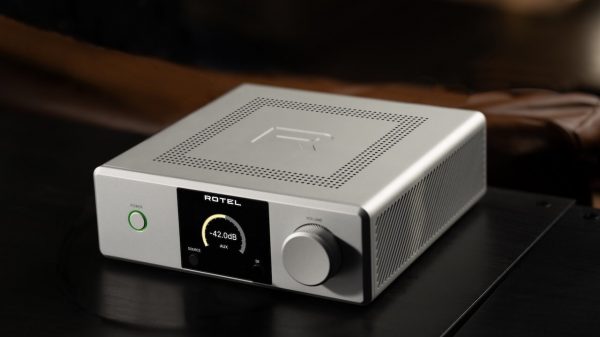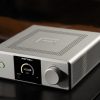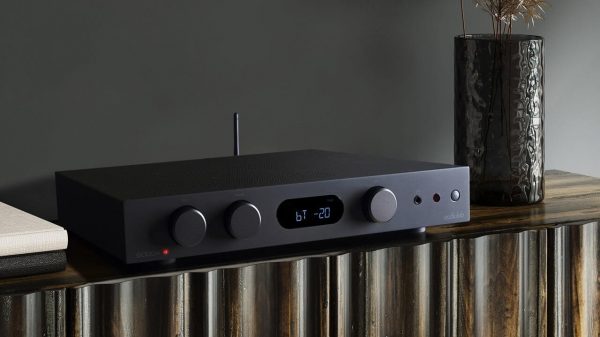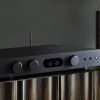Is the writing on the wall for expensive separates? Has the convergence of streaming, class D amplification, headphone listening, and the resurgence of vinyl pushed the boulder to the top of the mountain requiring only a slight nudge to begin its catastrophic descent into the magic kingdom? Does the Parasound HINT 6 Integrated Amplifier make sense in 2022 in the same way as the Naim Uniti Atom? I think it does.
Does it make sense to spend this much in 2022 with technology evolving at a rapid rate? Parasound does offer a comprehensive lineup of products for both two-channel and home theater enthusiasts but products like the Parasound HINT 6 demonstrate that the manufacturer has been paying close attention.
None of this comes as a surprise to the manufacturers who saw this coming long before the COVID pandemic and those manufacturers who have not already pivoted to integrated amplifiers and network amplifiers as the foundation of their lineups are going to find the future quite ugly.
My focus here is almost exclusively headphones, DACs, Dongle DACs, DAPs, and headphone amplifiers — but more than a few readers suggested that I turn my head towards the Parasound HINT 6. I’m very glad that I did.

The Skinny
Parasound doesn’t offer a dedicated model for headphone listening but I wondered if the HINT 6 with all of its features; including the ability to drive rather difficult loudspeakers made it a much better buy than some of the pricier headphone amplifiers that cross my desk.
Parasound not only offers all of the functions that one might find in a pre-amplifier with the HINT 6 but also an ESS DAC capable of 32-bit/384kHz decoding and a dedicated class A headphone amplifier.
I decided to see how the Parasound HINT 6 compared to the Bryston separates in my two-channel system and also how it stacked up against my reference RME ADI-2 PRO FSRBE DAC and Pass Labs HPA-1 Headphone Amplifier.
The price difference between the Parasound HINT 6 and my state-of-the-art system is rather substantial but if it even approached the level of performance that they offer — Parasound definitely needs to be on your list.
The HINT 6 is $3,200 USD and certainly priced to compete with some lofty products from Naim, Rega, Cambridge Audio, Rotel, and even Pass Labs. The aforementioned Pass Labs HPA-1 is $3,675 as a point of comparison.
I’ve been a customer of Parasound for some time with my Zphono Phono Pre-amplifier and I’m not alone in suggesting that the equipment is built to be very reliable; the brand was started in 1981 and the early focus was on professional equipment for recording and movie studios. Lucasfilm has used their products and even offered them screen credit for the first 3 Star Wars prequels.
The engineers were so impressed with the build and sound quality of the studio gear that they asked the company to start making it for their own systems at home.
That’s a pretty solid endorsement.
Fast forward to 2022, and the company has two lines including the HALO Series that are geared towards audiophile listeners.

The Fat
Parasound sent me the Halo HINT 6 which combines the power-amp section of the original Halo, the pre-amplifier section of their P-5 pre-amp, and an improved DAC and upgraded power supply.
The HINT 6 is rated at 160 watts (class A/AB) into a 8 ohm load and is capable of driving 4 ohm loads and dips to even lower impedances while remaining stable. It is designed to be the center piece of a home stereo system with all the features you’d expect from an integrated amplifier.
I received the silver trim version and the first thing you note when unboxing it is the size and heft. The HINT 6 is large and solid and definitely becomes the focal point of the system.

The front panel is very clean with two parallel lines of controls while the rear is much busier with all of the inputs and outputs save the two front panel 3.5mm ports.
There are enough input and output options to accommodate most system components and even enough for some of us reviewers that often have two or more turntables or other components connected at the same time to do comparisons.
On the front, there is a 3.5mm jack for a headphone and a second for connecting a portable music player. The rear panel has multiple rows of inputs and outputs as well with the digital inputs grouped on right and the analog toward the left.

On the top row, we have a pair of XLR balanced inputs, a second pair of XLR for balanced pre-amp output, and a third single XLR as a subwoofer output.
How many integrated amplifiers offer a balanced output in 2022 for a subwoofer?
On the bottom row, we have a phono input for the internal phono stage that can handle either MM or MC cartridges; there is a switch to select between the two and a grounding post.
There are also five sets of RCA analog inputs, followed by a dedicated pair of RCA ports for recording. If you still record using an older tape deck, the HINT 6 is designed for you.
Home theater enthusiasts are not left out in the cold with the HINT 6; not only are there bypass input jacks to use the HINT 6 as a very powerful two-channel amplifier but also a way to connect your existing subwoofers to the HINT 6 and let the AVR do all of the decoding.

The subwoofer outputs include both the aforementioned XLR output and a pair of RCA jacks with a shared crossover switch for full range or low pass and an adjustment dial for the low pass frequency filter cut-off.
The digital side is also rather comprehensive.
If you use a streamer, CD player, Roku box, and even a video game console — the HINT 6 offers two optical inputs, 1 S/PDIF Coaxial input, and a single USB Type-B connection.
Above the digital bank of inputs are the trigger connection port, the IR control ports, and the speaker binding posts. Finally, to the far right are the voltage selector and fused power connector and on/off switch.
The front panel is primarily controls rather than inputs with the previously mentioned headphone and auxiliary sockets, a large volume knob with visual feedback window, tone control, balance control, subwoofer level control, input knob, mute, and dimmer switch; the dimmer switch is a godsend at a time where every manufacturer has the LEDs on their equipment set to the highest possible brightness level.
The front panel is relatively straight forward but I do find the placement of the source buttons/LEDs rather odd; they don’t really correspond with the actual source. Weird.

The remote works very well but I don’t understand the use of plastic remotes in 2022 when you are charging $3,200 for a component. Spend the extra money on something that looks the part but also feels substantial and not something you want to lose.
Internally, the HINT 6 utilizes a large toroidal output transfer which definitely explains the 33 pounds; not only does the HINT 6 output a lot of power but it is very clean as well.
The HINT 6 manages to achieve a 103+ dB signal-to-noise ratio with a THD of 0.01% at normal listening levels and its still only 0.05% at 160 Watts output into 8 ohms. If you are willing to let the THD slide up a bit, the HINT 6 is easily capable of delivering 180 Watts into 8 ohms or over 250 Watts into 4 ohm speakers.
If you own something like the Magnepan LRS — this might be a very good long-term option even if it is more than four times the price of the loudspeakers.

Some of the reason for the cleanliness is the power transformer but a lot of credit also needs to go to the class A/AB amplification. The power amp circuit uses match JFET input stages (fully balanced) and MOSFET driver stages which allows for clean power, output, and efficiency.
The amplifier is a hybrid class A/AB design that helps deliver the best sound at normal listening levels while delivering better efficiency at higher power levels.
At normal listening levels, the HINT 6 operates as a pure class A amplifier for the best possible sound and only switches to AB at listening levels that I would deem entirely unreasonable with the speakers I had on hand to test with.
This does allow the HINT 6 drive a wider range of speakers than it could as a pure class A device while maintaining the best sound possible along the way.

The digital inputs are handled by an ESS 9018K2M DAC with USB offering 32-bit/384kHz PCM and DSD256. The other digital inputs are limited to 24-bit/192kHz PCM but that still covers a lot the music available today. MQA is not supported.
Listening
On paper and on the rack, the Parasound HINT 6 Integrated Amplifier feels like a very impressive amplifier for the money.
But how does it sound?
I removed my Mark Levinson/Bryston combination from my system and connected all of my sources to the HINT 6; including my BelCanto DAC and Magnepan MG3.5R loudspeakers.
If the HINT 6 could drive these rather difficult loudspeakers, it would probably work well with a wide range of speakers.
Not only did the Parasound not have any difficulty driving the MG3.5Rs, but I was surprised by just how fluid the sound was; my Levinson/Bryston combination has more low end control and grunt — but you’re talking a lot more money for the extra degree of impact and texture.

I listen to a lot of classical recordings and the HINT 6 really surprised me with how well it dealt with complicated orchestral pieces; instruments had excellent separation and I found myself often lost in how vivid the combination was. Voices were never lost in the mix and very easy to place.
The midrange resolution was also rather superb; Maggies excel with the human voice and the HINT 6 did not disappoint; texture, timbre, and so much presence with most recordings.
I also own a pair of vintage Klipsch Heresy II’s and I wanted to see if the HINT 6 had the headroom to drive them with rock, heavy metal, and other complex electronic pieces that can really load the room.
Not only did I barely have to turn the volume up, but the Klipsch sounded like different speakers; warmer, more mid bass punch, and far more finesse than I expected.
Some powerful amps do really well at driving loudspeakers; they just don’t have the resolution, detail, or timbre to make it all come together.
The Parasound HINT 6 surprised me with how smooth it could be without ever sounding dull. This is one integrated amplifier that doesn’t care what the competition might be — it’s ready to show off what it can do.
My Bel Canto DAC delivers more texture and depth in comparison to the HINT’s internal DAC, but it’s still very good considering how much else is offered under the hood.

Headphones?
The $64,000 question for me was how the HINT 6 would handle headphones.
I tested several sets of headphones and IEMs with the HINT 6 as well and that brought up one oddity. The 3.5mm jack is typically used for portables and IEMs, but the power of the HINT 6 is best suited for over-ear headphones as most of my IEM testing had some hiss present.
Here a 6.35mm jack would have been more appropriate as most headphones still ship with this size jack and the 6.35mm to 3.5mm adapters are generally lousy. A cable swap on the headphone to a 3.5mm terminated cable is a much better option if available but at an added cost to the consumer.
The headphone system worked well and again provided a nice neutral presentation with good detail and dynamics. I found it a bit better suited to the big dynamics like the Beyerdynamic T1 and Sennheiser HD800 but it was still quite capable of driving most of my planar collection as well.
It is not the right headphone amplifier for the HiFiMAN HE6 or the HEDD as both of those taxed it more than I would prefer and some loss of bass and clarity was present.
With the HD800, the soundstage shines and its dynamics are on full display with good impact and an almost visceral bass when present. The HD800 would be my headphone recommendation with the HINT 6.
Conclusion
The Parasound HINT 6 falls into a category with a lot of really powerful integrated amplifiers that are often more braun than finesse. I can’t say that it bests them all because I have not heard enough of them to make such a claim.
Would I buy the Parasound HINT 6 for headphone listening alone? Probably not. It’s very good at what it does but it doesn’t offer the resolution, resolving power, detail, or spaciousness of my RME/Pass Labs combination; it’s also less than 50% of the retail price of that combination so to expect it to outperform two of the best personal audio components currently available would be a rather steep hill to climb.
However, if I was in the market for a high-end integrated amplifier that could replace a $4,000 set of separates and deliver a lot of power, reliability, an excellent feature set including a plethora of input/output options — the Parasound HINT 6 Integrated Amplifier would be very high on my recommendation list.
When you consider how much it offers for $3,200 and how good it sounds — this is one of the best bargains right now in the high-end amplifier category. Parasound definitely delivers on its promise of sound quality and value for the money.
Where to buy: $3,199 at Crutchfield




































MadMex
July 28, 2022 at 2:34 am
Parasound, long distance runner for best bangs for your bucks in the hi-fi power game. Viva Taiwan, where they’ve long been manufactured.
Elton Crim Jr
July 28, 2022 at 11:31 am
It’s an excellent integrated amp. If you are in Wisconsin, you can order one and demo one at University Audio In Madison, WI.
Mike G.
September 6, 2022 at 1:22 am
I’ve owned an A21 and P5 for 5 years. Absolutely great sound with no problems at all. Great gear at reasonable prices. Very happy with this Parasound combo!!
Gary Vaiskauckas
October 31, 2022 at 2:28 am
I have owned the Parasound A52, P7 (7.1 channel analog preamp) paired with Oppo 205 (digital preamp) and Martin Logan 13A’s (L/R), C34A (center), FX2 (surrounds) in my Theater for years. I recently purchased the Magnepan LRS+ paired with A23+ and Oppo 105 as a DAC preamp for 2 channel listening. The A23+ was an recent upgrade to a vintage amp that struggled to drive the bass in the LRS+.
The Parasound amps bring out all of the rich detail in the recordings equally in the efficent Martin Logans and difficult to drive Maggies.
Ian White
October 31, 2022 at 2:06 pm
Gary,
Putting the A23+ on my list for my LRS. Thanks for the tip. I agree that Parasound makes some great equipment.
Best,
Ian White